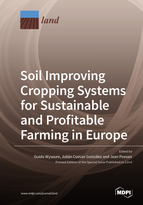Soil Improving Cropping Systems for Sustainable and Profitable Farming in Europe
A special issue of Land (ISSN 2073-445X).
Deadline for manuscript submissions: closed (30 April 2022) | Viewed by 58304
Special Issue Editors
Interests: irrigation; drainage; agrohydrology; land and water sustainability; soil management
Interests: Mediterranean and subtropical fruit crops; pollination; pollen–pistil interaction; fruit set and thinning; fruit crop physiology
Special Issues, Collections and Topics in MDPI journals
Special Issue Information
Dear Colleagues,
A major challenge for the future is to combine both the profitability and sustainability of agriculture. The European H2020 project SoilCare, aims to identify, test and evaluate soil-improving cropping systems (SICS) which contribute to the implementation of agricultural solutions across Europe (See: https://soilcare-project.eu/en/ for the project website). The project includes 16 study sites distributed across Europe. Each study site implemented short term experiments during the duration of the project and most also ran long term experiments comparing the soil quality as a function of different treatments such as soil amendments, tillage, cover crops, nutrients, organic matter inputs. In addition, eight work-packages assess different aspects encompassing reviewing the soil-improving cropping systems, the participatory analysis of implementation and selection, methodology and analysis, upscaling at the European level, policy analysis and support, and dissemination and communication. In this way SoilCare works on a providing a holistic approach to soil quality, spanning from biophysical to human interactions at different scales.
In this Special Issue, we aim to compile scientific findings on soil-improving cropping systems (SICS) based on field experiments, including the study of policy, upscaling and dissemination. We invite papers focussing on, but not limited to, the following topics:
- best practices for alleviating soil threats and improving soil quality based on long and short term experiments;
- methodologies for comparing SICS across study-sites and countries;
- policy development, upscaling of possible solutions, stakeholder involvement and dissemination of SICS.
Prof. Dr. Guido Wyseure
Prof. Dr. Julián Cuevas González
Prof. Dr. Jean Poesen
Guest Editors
Manuscript Submission Information
Manuscripts should be submitted online at www.mdpi.com by registering and logging in to this website. Once you are registered, click here to go to the submission form. Manuscripts can be submitted until the deadline. All submissions that pass pre-check are peer-reviewed. Accepted papers will be published continuously in the journal (as soon as accepted) and will be listed together on the special issue website. Research articles, review articles as well as short communications are invited. For planned papers, a title and short abstract (about 100 words) can be sent to the Editorial Office for announcement on this website.
Submitted manuscripts should not have been published previously, nor be under consideration for publication elsewhere (except conference proceedings papers). All manuscripts are thoroughly refereed through a single-blind peer-review process. A guide for authors and other relevant information for submission of manuscripts is available on the Instructions for Authors page. Land is an international peer-reviewed open access monthly journal published by MDPI.
Please visit the Instructions for Authors page before submitting a manuscript. The Article Processing Charge (APC) for publication in this open access journal is 2600 CHF (Swiss Francs). Submitted papers should be well formatted and use good English. Authors may use MDPI's English editing service prior to publication or during author revisions.
Keywords
- soil quality
- sustainable soil management
- cropping systems
- tillage systems
- cover crops
- soil policy and management
- soil organic matter management
- upscaling of best practices
- stakeholder involvement
- dissemination








